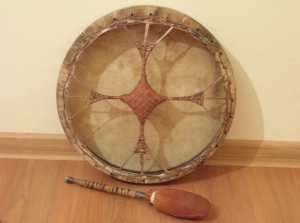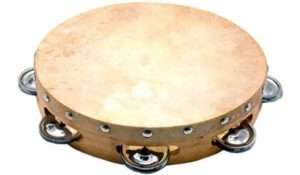
History drummed
Timbrel refers to ancient musical instruments and has a rich history.  The history of the tambourine dates back to ancient times, when shamans, performing their ritual rites, struck the tambourine, thereby making it clear about this or that important event.
The history of the tambourine dates back to ancient times, when shamans, performing their ritual rites, struck the tambourine, thereby making it clear about this or that important event.
A tambourine is a percussion musical instrument consisting of a leather material stretched over a wooden circle. To play the tambourine, it is important to have a sense of rhythm and an ear for music.
Musical performance on a tambourine is performed in 3 ways:
- sounds are created when the joints of the extreme phalanges of the fingers are struck;
- with shaking and convulsive tapping;
- creating sounds using the tremolo method. The sound is produced by rapid shaking.
Many historians believe that the first tambourine appeared in Asia in the 2nd-3rd century. It has received the greatest distribution in the Middle East and in the countries of Europe, having reached the shores of Great Britain. Over time, drums and tambourines will become “competitors” of the tambourine.  A little later, the design will change. The leather membrane will be removed from the tambourine. Ringing metal inserts and a rim will remain unchanged.
A little later, the design will change. The leather membrane will be removed from the tambourine. Ringing metal inserts and a rim will remain unchanged.
In Russia, the instrument appeared during the reign of Prince Svyatoslav Igorevich. At that time, the tambourine was called a military tambourine and was used in a military band. The tool raised the spirit of the soldiers. In appearance, it looked like a vessel. Beaters were used to make sounds. A little later, the tambourine became an attribute of holidays such as Shrovetide. The tool was used by buffoons and jesters to invite guests. At that time, the tambourine already had the appearance familiar to us.
A tambourine is often used by shamans during rituals. The sound of an instrument in shamanism can lead to a hypnotic state. The classic shaman tambourine was made from the skin of a cow and a ram. Leather laces were used to stretch the membrane. Each shaman had his own tambourine.
In Central Asia, it was called daf. Sturgeon skin was used for making.  Such material made a ringing sound. For increased ringing, small metal rings of about 70 pieces were used. And the Indians made a membrane from the skin of a lizard. A tambourine made of such material had amazing musical properties.
Such material made a ringing sound. For increased ringing, small metal rings of about 70 pieces were used. And the Indians made a membrane from the skin of a lizard. A tambourine made of such material had amazing musical properties.
Modern orchestras use special orchestral models. Such instruments have an iron rim and a plastic membrane. The tambourine is known among all peoples of the world. Its varieties are found almost everywhere. Each species has its own differences:
1. Gaval, daf, doira are known in eastern countries. They have a diameter of up to 46 cm. The membrane of such a tambourine is made of sturgeon skin. Metal rings are used for the hanging component. 2. Kanjira is an Indian version of the tambourine and is distinguished by high notes of sound. The diameter of the kanjira reaches 22 cm with a height of 10 cm. The membrane is made of reptile skin. 3. Boyran – an Irish version with a diameter of up to 60 cm. Sticks are used to play the instrument. 4. The Pandeiro tambourine gained popularity in the states of South America and Portugal. In Brazil, pandeiro is used for samba dances. A distinctive feature is the presence of adjustment. 5. Tungur is a tambourine of shamans, Yakuts and Altaians. Such a tambourine has a round or oval shape. On the inside there is a vertical handle. To support the membrane, metal rods are attached to the inside.
Real professionals and virtuosos with the help of a tambourine arrange a whole performance. They toss it into the air and quickly intercept it. The tambourine chimes when struck with the legs, knees, chin, head, or elbows.





